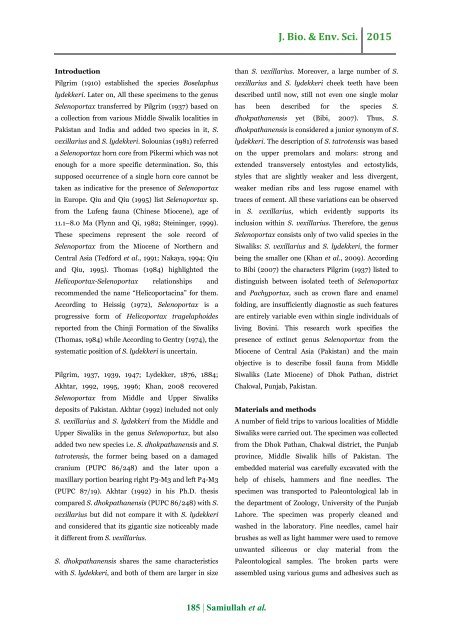Selenoportax vexillarius from Dhok Pathan, Chakwal District, the Punjab, Pakistan
The fossil material belonging to genus Selenoportax has been described and discussed which was collected from Dhok Pathan, Chakwal district, the Punjab province, Pakistan. The studied material comprises left lower mandibular ramus having p4-m3. The genus Selenoportax basically consists of two species; Selenoportax vexillarius and Selenoportax lydekkeri. Selenoportax is an extinct genus of Boselaphines. Boselaphines have been reported from Middle Miocene and abundantly from the Late Miocene of the Siwaliks. Selenoportax is a moderate to large sized boselaphine. Thorough examination and measurements reveals that studied specimen belongs to species Selenoportax vexillarius. Its fossils have been also reported from the Miocene of Northern and Central Asia. Get the full articles at: http://www.innspub.net/volume-6-number-5-may-2015-jbes/
The fossil material belonging to genus Selenoportax has been described and discussed which was collected from Dhok Pathan, Chakwal district, the Punjab province, Pakistan. The studied material comprises left lower mandibular ramus having p4-m3. The genus Selenoportax basically consists of two species; Selenoportax vexillarius and Selenoportax lydekkeri. Selenoportax is an extinct genus of Boselaphines. Boselaphines have been reported from Middle Miocene and abundantly from the Late Miocene of the Siwaliks. Selenoportax is a moderate to large sized boselaphine. Thorough examination and measurements reveals that studied specimen belongs to species Selenoportax vexillarius. Its fossils have been also reported from the Miocene of Northern and Central Asia. Get the full articles at: http://www.innspub.net/volume-6-number-5-may-2015-jbes/
Create successful ePaper yourself
Turn your PDF publications into a flip-book with our unique Google optimized e-Paper software.
J. Bio. & Env. Sci. 2015<br />
Introduction<br />
Pilgrim (1910) established <strong>the</strong> species Boselaphus<br />
lydekkeri. Later on, All <strong>the</strong>se specimens to <strong>the</strong> genus<br />
<strong>Selenoportax</strong> transferred by Pilgrim (1937) based on<br />
a collection <strong>from</strong> various Middle Siwalik localities in<br />
<strong>Pakistan</strong> and India and added two species in it, S.<br />
<strong>vexillarius</strong> and S. lydekkeri. Solounias (1981) referred<br />
a <strong>Selenoportax</strong> horn core <strong>from</strong> Pikermi which was not<br />
enough for a more specific determination. So, this<br />
supposed occurrence of a single horn core cannot be<br />
taken as indicative for <strong>the</strong> presence of <strong>Selenoportax</strong><br />
in Europe. Qiu and Qiu (1995) list <strong>Selenoportax</strong> sp.<br />
<strong>from</strong> <strong>the</strong> Lufeng fauna (Chinese Miocene), age of<br />
11.1–8.0 Ma (Flynn and Qi, 1982; Steininger, 1999).<br />
These specimens represent <strong>the</strong> sole record of<br />
<strong>Selenoportax</strong> <strong>from</strong> <strong>the</strong> Miocene of Nor<strong>the</strong>rn and<br />
Central Asia (Tedford et al., 1991; Nakaya, 1994; Qiu<br />
and Qiu, 1995). Thomas (1984) highlighted <strong>the</strong><br />
Helicoportax-<strong>Selenoportax</strong> relationships and<br />
recommended <strong>the</strong> name “Helicoportacina” for <strong>the</strong>m.<br />
According to Heissig (1972), <strong>Selenoportax</strong> is a<br />
progressive form of Helicoportax tragelaphoides<br />
reported <strong>from</strong> <strong>the</strong> Chinji Formation of <strong>the</strong> Siwaliks<br />
(Thomas, 1984) while According to Gentry (1974), <strong>the</strong><br />
systematic position of S. lydekkeri is uncertain.<br />
Pilgrim, 1937, 1939, 1947; Lydekker, 1876, 1884;<br />
Akhtar, 1992, 1995, 1996; Khan, 2008 recovered<br />
<strong>Selenoportax</strong> <strong>from</strong> Middle and Upper Siwaliks<br />
deposits of <strong>Pakistan</strong>. Akhtar (1992) included not only<br />
S. <strong>vexillarius</strong> and S. lydekkeri <strong>from</strong> <strong>the</strong> Middle and<br />
Upper Siwaliks in <strong>the</strong> genus <strong>Selenoportax</strong>, but also<br />
added two new species i.e. S. dhokpathanensis and S.<br />
tatrotensis, <strong>the</strong> former being based on a damaged<br />
cranium (PUPC 86/248) and <strong>the</strong> later upon a<br />
maxillary portion bearing right P3-M3 and left P4-M3<br />
(PUPC 87/19). Akhtar (1992) in his Ph.D. <strong>the</strong>sis<br />
compared S. dhokpathanensis (PUPC 86/248) with S.<br />
<strong>vexillarius</strong> but did not compare it with S. lydekkeri<br />
and considered that its gigantic size noticeably made<br />
it different <strong>from</strong> S. <strong>vexillarius</strong>.<br />
S. dhokpathanensis shares <strong>the</strong> same characteristics<br />
with S. lydekkeri, and both of <strong>the</strong>m are larger in size<br />
than S. <strong>vexillarius</strong>. Moreover, a large number of S.<br />
<strong>vexillarius</strong> and S. lydekkeri cheek teeth have been<br />
described until now, still not even one single molar<br />
has been described for <strong>the</strong> species S.<br />
dhokpathanensis yet (Bibi, 2007). Thus, S.<br />
dhokpathanensis is considered a junior synonym of S.<br />
lydekkeri. The description of S. tatrotensis was based<br />
on <strong>the</strong> upper premolars and molars: strong and<br />
extended transversely entostyles and ectostylids,<br />
styles that are slightly weaker and less divergent,<br />
weaker median ribs and less rugose enamel with<br />
traces of cement. All <strong>the</strong>se variations can be observed<br />
in S. <strong>vexillarius</strong>, which evidently supports its<br />
inclusion within S. <strong>vexillarius</strong>. Therefore, <strong>the</strong> genus<br />
<strong>Selenoportax</strong> consists only of two valid species in <strong>the</strong><br />
Siwaliks: S. <strong>vexillarius</strong> and S. lydekkeri, <strong>the</strong> former<br />
being <strong>the</strong> smaller one (Khan et al., 2009). According<br />
to Bibi (2007) <strong>the</strong> characters Pilgrim (1937) listed to<br />
distinguish between isolated teeth of <strong>Selenoportax</strong><br />
and Pachyportax, such as crown flare and enamel<br />
folding, are insufficiently diagnostic as such features<br />
are entirely variable even within single individuals of<br />
living Bovini. This research work specifies <strong>the</strong><br />
presence of extinct genus <strong>Selenoportax</strong> <strong>from</strong> <strong>the</strong><br />
Miocene of Central Asia (<strong>Pakistan</strong>) and <strong>the</strong> main<br />
objective is to describe fossil fauna <strong>from</strong> Middle<br />
Siwaliks (Late Miocene) of <strong>Dhok</strong> <strong>Pathan</strong>, district<br />
<strong>Chakwal</strong>, <strong>Punjab</strong>, <strong>Pakistan</strong>.<br />
Materials and methods<br />
A number of field trips to various localities of Middle<br />
Siwaliks were carried out. The specimen was collected<br />
<strong>from</strong> <strong>the</strong> <strong>Dhok</strong> <strong>Pathan</strong>, <strong>Chakwal</strong> district, <strong>the</strong> <strong>Punjab</strong><br />
province, Middle Siwalik hills of <strong>Pakistan</strong>. The<br />
embedded material was carefully excavated with <strong>the</strong><br />
help of chisels, hammers and fine needles. The<br />
specimen was transported to Paleontological lab in<br />
<strong>the</strong> department of Zoology, University of <strong>the</strong> <strong>Punjab</strong><br />
Lahore. The specimen was properly cleaned and<br />
washed in <strong>the</strong> laboratory. Fine needles, camel hair<br />
brushes as well as light hammer were used to remove<br />
unwanted siliceous or clay material <strong>from</strong> <strong>the</strong><br />
Paleontological samples. The broken parts were<br />
assembled using various gums and adhesives such as<br />
185 | Samiullah et al.


















